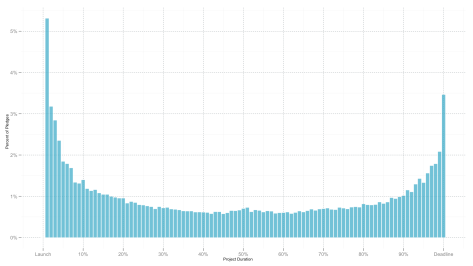About half of our clients’ campaigns experience some sort of platform glitch.

Sometimes these arise prior to launch, and sometimes during or even after the campaign. It can be pretty stressful. Some examples include:
- A required form in the “Payments” section that wouldn’t save the correct campaign owner birthdate, which interfered with funding
- Accidentally putting the wrong checking account information in, and then not being able to change it, which led to a delay in payments after the campaign
- Accidentally launching the campaign several days too early, and then being unable to “un-launch” it
- Delays in the platform’s campaign review process, which led to a delay in launch
- Being unable to reconcile the reports from the platform and the payments processor until two weeks after campaign close
- An erroneously generated platform email that bombarded the campaign owner’s inbox every time a pledge was made
Adding to the stress is the fact that neither major platform (Kickstarter nor Indiegogo) have a phone or chat help line. Problems are addressed via email. Our observation is that getting a problem resolved typically takes 24-72 hours, M-F. The pattern is:
- Client submits help request through online form
- Platform immediately sends autoresponse email with help ticket number
- Platform sends generic response email within 24 hours, with the same information that is in the “help” section on their website, which invariably is not helpful
- Client replies to that email, saying thank you, but that does not solve my problem, which is [x]
- Finally, platform actually solves problem within another 24-48 hours and an actual person sends email to Client to that effect.
In over three years we have so far not had a problem come up that was not ultimately solved. But the solution has never been instantaneous. Both Indiegogo and Kickstarter update their interfaces regularly, meaning there is a constant source of new glitches. It can be pretty harrowing. It’s tough advice to follow, but if you are in the midst of a glitch, don’t panic.
Finally, here are a few pointers to avoid some common glitch issues altogether:
- Some core information, like payment and identity information, is locked once submitted. Enter this information early, when you are clear-headed, not in a rush, and have a level-headed person with you to doublecheck your entries before you hit “submit”.
- Be very careful any time your mouse approaches the “launch” button. Don’t click through dialogue windows on autopilot. Don’t launch when you mean to “save draft”.
- Remember that Kickstarter and some other platforms will need to approve your campaign before it is eligible for launch. Submit your campaign for review 3+ days before you plan to launch so there is time to get their approval or correct any issues.
- Generally speaking, enter core information early so that if there are issues, you have plenty of time to resolve them.
If you would like a free personalized diagnostic of your crowdfunding idea – a $125 value! – please fill out our Artist Questionnaire. We typically respond within two weeks.













